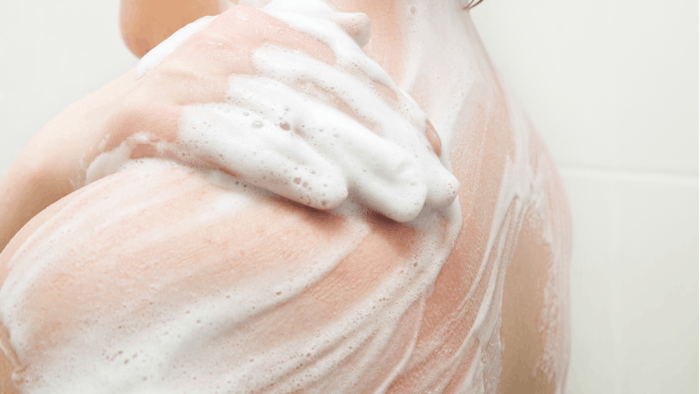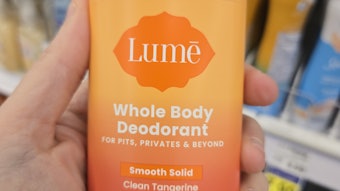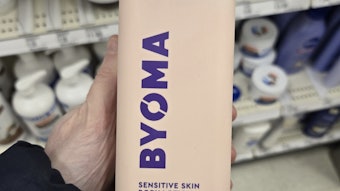
Keratosis pilaris (KP) is a painless, harmless skin condition that causes dry, rough patches and tiny bumps. Typically, this condition is located on the upper arms, thighs, cheeks or buttocks. There is no known cure or prevention and it can affect the quality of life of individuals, diminishing their confidence and self-esteem. Some may even opt to wear certain clothing to cover flare-ups.
Related: Saltair Launches KP Body Scrub
The condition is caused by an excess build-up of keratin at the opening of hair follicles that creates symptoms such as tiny bumps, rough skin and a sandpaper-like texture similar to “chicken skin.” Although it is unknown why KP appears only in some individuals, it is suspected to be associated with a genetic disease or atopic dermatitis.1 According to the Cleveland Clinic, some dermatologists find KP so common that they consider it a skin type, rather than a skin condition. About 50% to 80% of teenagers and 40% of adults will develop these bumps at some point during their lives.2
Just like the condition, which can present in all skin types and ages, the treatment can come in an array of options. A general Google search will bring a variety of product types ranging from lotions and creams, to body washes and scrubs. According to the Mayo Clinic, there are two major ways to treat KP: remove dead skin cells, and prevent or reduce clogged follicles.
There is no known cure or prevention and it can affect the quality of life of individuals, diminishing their confidence and self-esteem.
To remove dead cells, products containing glycolic acid, lactic acid or salicylic acid are recommended, which assist with accelerating the resurfacing of skin. Depending on the concentration of these creams, they can be effective or sensitizing, and may cause redness, stinging or skin irritation, so they are not recommended for young children.
To reduce clogged follicles, creams based on vitamin A or retinol work by promoting cell turnover. They also prevent hair follicles from becoming plugged. Retinol can also increase sensitization in the skin, however, so it is important for the user to patch test products on the skin or consult with a dermatologist before using them.3
Formulating for Keratosis Pilaris
When formulating a body wash for KP, one must consider that: 1) the wash will contain low pH acids, and the final formula of the product should range between 5.0-5.5 to ensure ideal product efficacy and performance; 2) not all surfactants are supported at low pH levels, so those that are compatible with acid but gentle on the skin should be selected; and 3) surfactants and acids can be sensitizing to the skin, so creating a gentle but effective formula is the goal.
Surfactants
The first type of surfactant vital this body wash will be anionic, which contains a negatively charged hydrophilic group. Common ions found on the hydrophilic head include carboxylate, sulfate or sulfonate. These types of surfactants provide cleansing and foaming action. Common ones found in skin care include alkyl sulfates and alkyl ethoxylated sulfates.
Anionic surfactants can also be a bit irritating. Sulfonic acid, phosphate esters, glutamates and taurates are slightly milder than sulfates, which can be added to sulfates or used as replacements to help reduce skin sensitivity. These milder surfactants are ideal for treating KP, in this author's view. Some options include sodium C14-16 olefin sulfonate, sodium methyl cocoyl taurate and lauramide MEA.
One unique surfactant molecule that theoretically contains both negative and positive charges is characterized as zwitterionic, or more commonly termed amphoteric. Amphoteric surfactants boost foam, improve conditioning and reduce irritation. These properties make amphoteric surfactants especially relevant for creating a body wash for those with sensitized skin.
Amphoteric surfactants are notably pH sensitive; at a low pH they will exhibit similar conditioning properties to those found in cationic surfactants. At a high pH, they will impart characteristics similar to anionic surfactants. This type of surfactant is useful alongside anionic surfactants to optimize cleaning action, foaming and skin tolerance.
Some examples of amphoteric surfactants include propionates, betaines and amphoacetates.4 Common examples include cocamidopropyl betaine, minkamidopropyl betaine, sodium lauroamphoacetate and cocamidopropyl hydroxysultaine.5
Humectants
Humectants are hygroscopic ingredients that facilitate hydration in the skin by controlling moisture loss and redistributing moisture within skin to the stratum corneum. This type of ingredient will often contain at least one hydrophilic group, such as hydroxyl, carboxyl and/or amine.
These hydrophilic groups form the hydrogen bonds with water molecules readily found in the skin. This takes them from the dermis and epidermis and pulls them up toward the stratum corneum, filling in voids in the skin through swelling—hence the plumping and soothing properties typical of humectants.6
These types of ingredients, for a body wash, help to stabilize the formula and assist with the foaming, spreadability and texture of the final product. Some humectant options include glycerin, propanediol, isopentyldiol and apple fruit extract.
Acids
Finally, acids are what make the body wash "liquid gold" for those suffering from KP. Two major types of acid will help to treat KP: AHAs and BHAs. Depending on the desired strength of the body wash, the formulator may select just one AHA, one BHA or a blend of both.
Salicylic acid is an ideal BHA for this type of application, in this author's view, as it works specifically to unclog pores. However, it is important to note that salicylic acid is an over-the counter drug and is to be used between 0.5-2.0%.7 Salicylic acid is also oil-soluble and must be solubilized into water-based body wash systems for it to be completely stable.
Related: FDA Issues Warnings, Pushes Consumer Education of OTC Skin Lightening Products
AHAs are known to help smooth fine lines, improve skin texture and tone, and to unblock and cleanse pores.8 They work by shedding the skin surface—and the potency and extent of this exfoliation is dependent upon the concentration and final pH.
The use of AHAs between 4% and 10% at a pH of 3.5-4.5 provides their known anti-aging properties, e.g., reducing hyperpigmentation, inflammation and acne with regular use. AHAs are typically water soluble; examples include glycolic, malic, tartaric, lactic and mandelic.9 It is important to check the pH of the final product to ensure that it remains between 3.5-4.5 for maximum efficacy.
Conclusion
Although KP is a painless, harmless skin condition, as stated, it can affect the quality of life of individuals, which is why creating products to treat this condition is imperative. Designing an effective body wash to improve KP requires optimizing the surfactant system, humectants and acids.
Aside from including these crucial ingredients, it is vital to ensure the pH of the final product is taken into account, as well as its potential to be sensitizing to skin. The final formula must be both effective and gentle, encompassing both science and art.
References
[1] https://www.mayoclinic.org/diseases-conditions/keratosis-pilaris/symptoms-causes/syc-20351149
[2] https://my.clevelandclinic.org/health/diseases/17758-keratosis-pilaris
[3] https://www.mayoclinic.org/diseases-conditions/keratosis-pilaris/diagnosis-treatment/drc-20351152
[4] https://onlinelibrary.wiley.com/doi/epdf/10.1111/j.1600-0536.1995.tb00470.x
[5] https://www.cosmeticsandtoiletries.com/cosmetic-ingredients/cleansing/article/21836367/cosmetics-toiletries-magazine-formulating-on-trend-hand-cleansers-and-surfactant-review
[6] Baki, G. and Alexander, K.S. (2015, Mar). Introduction to cosmetic formulation and technology. Wiley. Available at: https://www.wiley.com/en-us/Introduction+to+Cosmetic+Formulation+and+Technology-p-9781118764893
[7] https://www.accessdata.fda.gov/scripts/cdrh/cfdocs/cfcfr/CFRSearch.cfm?fr=333.310&SearchTerm=salicylic%20acid
[8] https://www.fda.gov/cosmetics/cosmetic-ingredients/alpha-hydroxy-acids
[9] https://www.cosmeticsandtoiletries.com/formulas-products/formulating-basics/article/21965335/formulating-on-trend-aha-deodorant










